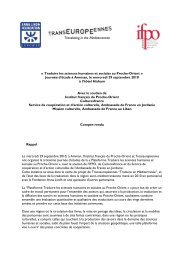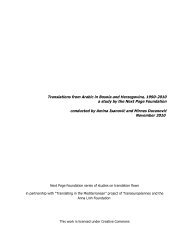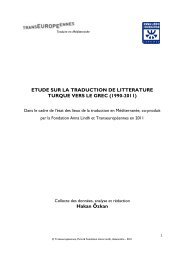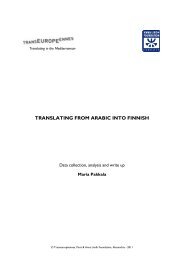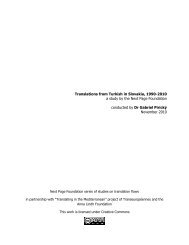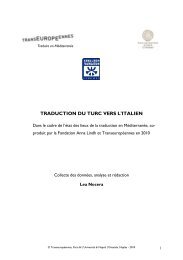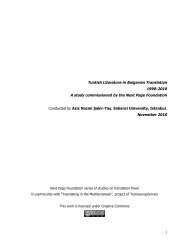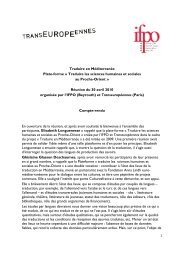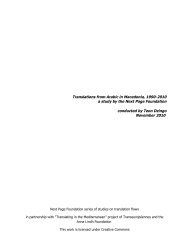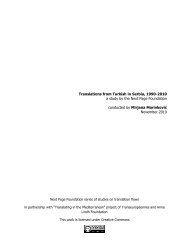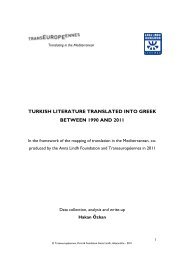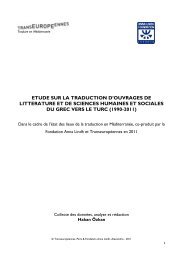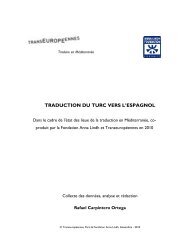TIM 2010 EastEuro-Arabic Next Page Foundation - Transeuropéennes
TIM 2010 EastEuro-Arabic Next Page Foundation - Transeuropéennes
TIM 2010 EastEuro-Arabic Next Page Foundation - Transeuropéennes
- No tags were found...
Create successful ePaper yourself
Turn your PDF publications into a flip-book with our unique Google optimized e-Paper software.
the Arab world. To achieve a notable impact on the dynamics of translations, these programsneed time to establish working relations with Arab publishers as well as to cultivate asufficiently large number of translators who would create their market within giventranslation projects.Second, funding comes from public and private sources in the Arab world, which operatewithin the general framework of contributing to the advancement of knowledge and culturein the Arab world. In the case of CEE languages, these include the National TranslationProject of the Supreme Council for Culture in Egypt, the General Egyptian BookOrganization, the National Council for Culture, Arts and Letters (NCCAL) inKuwait and the Syrian Ministry of Culture. Due to the lack of transparency of many ofthese programs, it is difficult to establish the exact number of translations they havesupported from CEE languages.While the European-led programs routinely provide grants for translations on the basis ofopen competition for publishers’ subventions, their Arab counterparts often commission titlesof their choice or publish the books themselves. Arab-funded programs typically ensurelower cover prices of the funded books as part of their policy for promoting wider audienceaccess.A relatively recent addition is the Encounters program 8 of the <strong>Next</strong> <strong>Page</strong> <strong>Foundation</strong>. Itsspecial focus on encouraging the translation flow between East European languages and<strong>Arabic</strong> makes it unique in the translation funding landscape. The program supportstranslations in both directions – from <strong>Arabic</strong> into East European languages and from theselanguages into <strong>Arabic</strong> by co-funding mutual translations of contemporary prose, essays andtexts in the humanities. Since the mere provision of a limited number of mutual translations– while a desirable aim in itself – is believed to have a limited impact, the broader approachis to supplement the grant scheme with other activities such as direct encounters with keyorganizations (at workshops, fairs and other events) and a survey of the translation policiesin both regions. So far the program has supported the publication of seven book titles andtwo journal issues 9 of translations from <strong>Arabic</strong>. For a detailed account of the program’sdevelopments regarding translations into <strong>Arabic</strong>, see section 2.6. below.It should be noted that, with few exceptions, funding programs focus on financing thepublication itself (copyrights, translation and sometimes even the printing costs), while otherforms of support such as promotion budgets, fellowships for translators, participation inevents, readings and authors’ visits, etc. are almost completely lacking.3. Some notable initiatives and channelsSince the diversity of the cultural and literary ties between the 12 CEE countries and theArab-speaking world makes general statements on the factors that affect these translationsimpossible, we have chosen instead to consider several notable cases of successful orimportant initiatives and channels. The list below is by no means exhaustive; rather, eachexample emphasizes a specific aspect of publishing this kind of translation.3.1. Consistent publishing policy8http://www.npage.org/article172.html9For a full list of supported projects, visit http://www.npage.org/article202.html9



